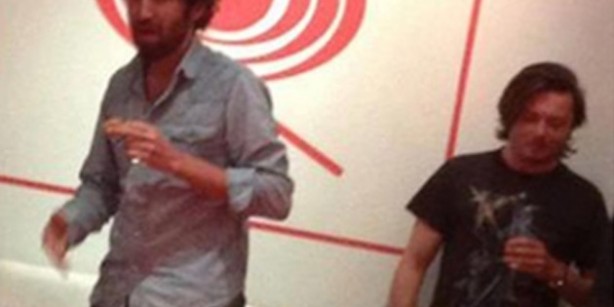 Music
Music
TRENDSPOTTING: All-star collaborations show Daft Punk are human after all
by Richard Trapunski
June 19, 2013
“Here’s What Daft Punk Look Like Without Their Helmets.”
That headline, or some variation of it, appeared on everything from Gawker to Huffington Post to Buzzfeed after New York City duo the Knocks posted a photo of Thomas Bangalter and Guy-Manuel de Homem-Christo to their Facebook page in early June. That’s all it was; a grainy iPhone photo of a pair of blurry faces, uploaded and then hastily removed, but it made the music blog rounds as quickly as a Kanye rant or a two-second snippet of ambient synths presumed to be new Boards of Canada music.
For those with stringent memories, it wasn’t the first glimpse behind the robot masks, but it was the first since the neverending mega-campaign that turned Random Access Memories into the biggest event album since My Beautiful Dark Twisted Fantasy. After the slow teasing of Daft Punk information climaxes with the album’s release, fans clamour for a new mystery, and there’s no bigger enigma than their anonymity.
Before the most recent rise of EDM, anonymous was the default position for most performers. They didn’t all hide behind masks, but they most often set up to spin in the corner of the room. The DJ wasn’t the spectacle; the party was. This was the culture Daft Punk grew out of, their early masks and Spike Jonze-assisted dog-head abstraction a way to foreground character and story over biographical context. But when 2001’s Discovery blew up, so did their costumes and backstories, to the point that their LED helmets cost somewhere in the neighbourhood of $65,000, the elaborate story behind them resembling a big-budget sci-fi musical. As the men behind the masks shunned celebrity, their characters became huge arena stars.
Ironically, that helped popularize the new breed of rock-star DJs, led by Skrillex, a former emo-core kid with an undercut. Fans are clamouring for approachable electro-stars, and even helmeted DJ’s like Deadmau5 are willing to give it directly to them through social media. So it’s no surprise that fans are lusting after a glimpse of the “real” Daft Punk – just a couple of regular dudes, playing champagne pong at the international headquarters of their major label – but it feeds into the “star system” the duo attempt to shirk. So on Random Access Memories, they find yet another way to avoid the spotlight: they shine it on their collaborators.
By surrounding themselves with a crack team of big-name session players and guest players, Daft Punk actually situate themselves back into the classical conception of DJ as synthesizer, fusing disparate styles into a cohesive, danceable, vocoder-heavy package. Want to create a disco song? Sure, here’s Chic’s Nile Rodgers on guitar. A schmaltzy, multi-suite over the dystopian Broadway tune? Here’s Muppets songwriter Paul Williams. Soul? Pharrell Williams. Swagger? Julian Casablancas. Boiled down, Random Access Memories is like an old-fashioned DJ set, except with humans instead of records.
Replace DJ with “selector,” and you’ve hit upon the formula for Free The Universe, the long-delayed second album from blue-eyed electro-dancehall team Major Lazer. Since the release of their debut, one half of the duo, Switch, left the group, while the public face, Skerrit Bwoy stopped daggering long enough to find Jesus. Meanwhile, sole remaining member, Diplo, ascended to superstar producer, overshadowing any G.I. Joe-aping cartoon backstory he deemed to feed the press.
Filling the album with pop and indie boldfaces like Santigold, Bruno Mars, and Peaches allows Diplo to step back, while placing real-deal dancehall stars like Elephant Man and Vybz Cartel alongside fake-patois sporting cardigan-rockers from Dirty Projectors and Vampire Weekend helps him sidestep sticky accusations of cultural appropriation. It doesn’t hurt that the public face of Major Lazer is a bionic Jamaican super-commando nightclub owner who fights zombies and vampires on a rocket-powered skateboard. Like Gorillaz and their all-star Plastic Beach album, it’s hard to notice the departure of a major member when the cast of chart-topping characters is so colourful.
That approach tends to sink when applied to rock music, because egos are too big to share marquee space with others. That’s precisely why supergroups never work out as well onstage as on paper, but it doesn’t stoop old-school guitar-wielders from trying. So perhaps it’s no surprise that Josh Homme succumbed to the temptation in 2009, joining Dave Grohl and Led Zeppelin bassist John Paul Jones for the forgettable Them Crooked Vultures project. From his early days in Kyuss to his let’s-get-fucked-up-and-jam side project the Desert Sessions to Queens of the Stone Age, the ginger axe-man has struggled to combine his spirit of collaboration with his larger than life muscle-and-swagger personality.
But for one brief, fleeting moment, he managed to find the perfect balance. 2002’s Songs For The Deaf balanced metal screamer Nick Oliveri with gravelly crooner Mark Lanegan, the smooth voiced Homme and drum-destroyer Dave Grohl to create a diverse burst of pop-metal that approached sublimity in its all-over-the-map construction. That same cast of rockers returns for Queens of the Stone Age’s latest album, …Like Clockwork, alongside other big names like Trent Reznor, Scissor Sisters’ Jake Shears, and, yep, Elton John, but this time the guest stars are little more than window dressing. The press release may foreground the supporting cast, but without the liner notes and a quick pause-and-rewind trigger finger, you’d be hard pressed to hear any of them.
Daft Punk avoid that pitfall on Random Access Memories because they never wanted the spotlight to begin with. By leaving the preening to their collaborators and teasing out the influences that were there all along, Bangalter and de Homem-Christo get to stay behind their masks while showing that, yes, they’ve been human all along.
Tags: Music, News, AUX Magazine, Daft Punk, Trendspotting





